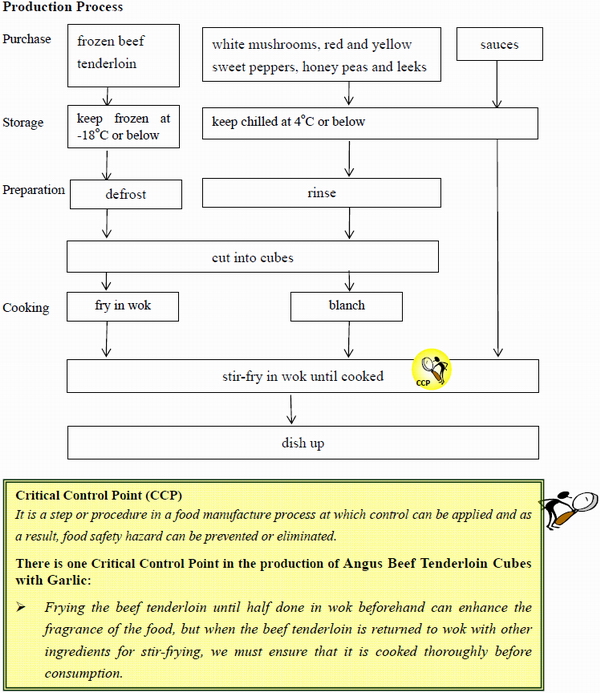
Food Safety Bulletin for Consumers 2013 (4th Issue)
Feature Article
Tetrodotoxin
Tetrodotoxin is a potent marine neurotoxin. Puffer fish, of which common names include balloon fish, globe fish, fugu, toad fish and blow fish (see illustration), and porcupine fish are common examples of fishes belonging to the order Tetraodontiformes which contain tetrodotoxin. Tetrodotoxin has also been isolated from other animal species like goby, shellfish, California newt, parrotfish, frogs of the genus Atelopus, the blue-ringed octopus, starfish, angelfish and xanthid crabs.
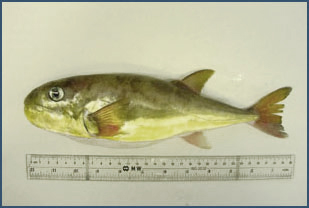
Some species of poisonous puffer fish: Green rough-backed puffer (Lagocephalus lunaris) (courtesy of the Agriculture, Fisheries and Conservation Department)
Tetrodotoxin is considered likely to be produced by marine bacteria that are often associated with marine organisms. In puffer fish, the distribution of tetrodotoxin is mainly in the ovaries (eggs), liver and skin. The muscle is normally free of toxin. However, tetrodotoxin can also be present in the muscle of some toxic gobies such as Yongeichthys nebulosis.
Tetrodotoxin is very heat-stable and likely to remain in fish tissues after food preparation steps (e.g. cooking and dehydration). Eating fish which contain tetrodotoxin such as puffer fish and porcupine fish can therefore be hazardous.
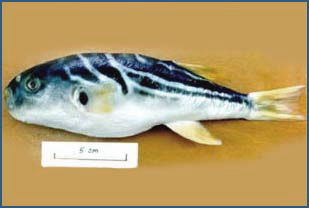
Yellow fin puffer (Takifugu xanthopterus) (courtesy of the Agriculture, Fisheries and Conservation Department)
Toxicity of Tetrodotoxin
While the lethal dose of tetrodotoxin for humans is around 1 to 2 milligrams, the minimum dose necessary to cause poisoning symptoms has been estimated to be 0.2 milligrams. Symptoms of tetrodotoxin poisoning usually develop within 10 to 45 minutes after ingestion, but may be delayed by 3 hours or more. Victims may experience paraesthesia in the face and extremities, which may be followed by dizziness or numbness, nausea, vomiting, diarrhoea and epigastric pain. Later, respiratory distress such as rapid breathing may occur, which may be accompanied with low blood pressure, convulsions and irregular heart rate. In general, victims may remain conscious until shortly before death, which usually takes place within 6 hours after ingestion. All humans are susceptible to tetrodotoxin poisoning. Since there are currently no known antidotes or antitoxins to tetrodotoxin, therapy is hence supportive.
The toxicity and toxin distribution within tissues vary among different species of puffer fish. Moreover, the level and composition of toxins in puffer fish may occasionally vary depending on the season and location, and between fish. Consumption of only a small amount of puffer fish may lead to tetrodotoxin poisoning.
Advice to Consumers
- Avoid purchasing and dressing puffer fish, porcupine fish or unknown fish for consumption on your own.
- Avoid consuming puffer fish is the best way to prevent tetrodotoxin poisoning.
Further information
Further information on tetrodotoxin is posted on the website of the Centre for Food Safety (CFS) at www.cfs.gov.hk.
Readers' Corner
The Dietary Exposure of the Local Population to Acrylamide
On 29 July 2013, the CFS released the sixth report of the First Hong Kong Total Diet Study (HKTDS), which covers the dietary exposure of the local population to acrylamide. According to the study, the dietary exposure of the local population to acrylamide was found to be low, relative to other countries and regions (including the United States, Canada, Europe, New Zealand and the Mainland). However, the risk assessment based on the estimated dietary exposure of the local population to acrylamide may indicate a cause for health concern.
Acrylamide is an industrial chemical used in the production of polyacrylamide. Recent research has found that it is formed when foods are cooked or processed at high temperature. Upon heating, the free amino acid, asparagine, in food reacts with reducing sugars to form acrylamide. The chemical is a genotoxic carcinogen and will possibly cause toxic effects on the nervous system, and adverse reproductive and developmental effects in experimental animals. However, epidemiological studies do not show a positive correlation between the level of dietary exposure to acrylamide and the incidence of cancer in humans.
The CFS has conducted several studies on acrylamide in food, mainly on foods reported to contain high levels of acrylamide. The risk assessment study in 2010 suggested that the dietary exposure to acrylamide of the local population might affect health. As a result, acrylamide was analysed in the first HKTDS with a view to obtaining an estimate of dietary exposure to acrylamide from the whole diet.
The acrylamide levels of a total of 133 food items (with 17 fruit items excluded) were analysed. Results showed that among the food items, potato chips were found to contain the highest level of acrylamide (mean: 680 microgram (μg)/kg), followed by fried potato (mean: 390 μg/kg) and zucchini (mean: 360 μg/kg).
As for dietary exposure estimation, the dietary exposure to acrylamide of the average and high consumer in the local population was 0.21 and 0.54μg/kg of body weight per day respectively, and their margins of exposure (MOE)* were all well below 10,000 (847 – 1,459 for the average population, 334 – 576 for the high consumers). [*The MOE value is defined as the ratio of the benchmark dose lower confidence limit for a 10 per cent extra risk of tumours (BMDL10) from animal study to the estimated dietary exposure to acrylamide of the local population. The Joint Food and Agriculture Organization/World Health Organization Expert Committee on Food Additives adopted the MOE approach for assessing the risks of acrylamide to human health. For genotoxic carcinogens, an MOE value below 10,000 would be of concern from a public health point of view. The lower the MOE, the greater the health concern.]
The influence of different cooking methods in the formation of acrylamide in vegetables is worth noting as revealed from the results of this study. According to the study, the main dietary source of acrylamide for the local population was from "vegetables and their products", particularly stir-fried vegetables (44.9%), including Chinese flowering cabbage, water spinach, zucchini and onion. Nevertheless, some kinds of stir-fried vegetables, such as Chinese spinach, watercress, spinach and Chinese lettuce were detected to have low levels of acrylamide, and in non-cooked, boiled or steamed vegetables like European lettuce, cucumber and hairy gourd, acrylamide was not detected.
Since the formation of acrylamide while frying vegetables may depend on many factors (such as the amount of asparagine and reducing sugars in the vegetables, and the frying temperature and duration), further testing on the formation of acrylamide in stir-frying vegetables with and without cooking oil added under different cooking conditions was conducted. Samples of fried vegetables prepared by restaurants were also taken for testing of acrylamide. The findings indicated that a higher level of acrylamide was formed where the vegetables were fried at a higher temperature and for a longer time. Lower acrylamide levels were found in the vegetables sampled from restaurants compared with HKTDS samples of the same kind of vegetables. As blanching of vegetables before stir-frying was common in restaurants, such a practice may help reduce the formation of acrylamide. However, no obvious associations were observed in acrylamide levels for frying vegetables with or without cooking oil added.
The CFS advises the food trade to find ways to reduce the level of acrylamide in food. Meanwhile, the CFS has revised the "Trade Guidelines on Reduction in Acrylamide Level" issued in 2011. Members of the trade may refer to the trade guidelines for ways to reduce the level of acrylamide in food during the selection of raw materials and the formulation of recipes and food processing conditions. Taking potato products such as French fries and potato chips as an example, the food trade may consider selecting potato varieties with low reducing sugar levels and optimise the cooking temperature and time to avoid overcooking.
The full report on the study on acrylamide and the trade guidelines are available on CFS's website at www.cfs.gov.hk.
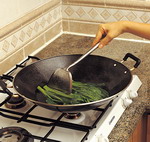 Blanching the vegetables before frying, or cooking them by boiling or steaming may help reduce the level of exposure to acrylamide from vegetables.
Blanching the vegetables before frying, or cooking them by boiling or steaming may help reduce the level of exposure to acrylamide from vegetables.
Food Safety Tips for Travellers
Travelling can be exciting and rewarding, but can also carry potential risks. Contaminated water or food can cause a variety of diseases that range from mild and short-lived symptoms (e.g. vomiting, diarrhoea) to longer lasting and more severe diseases (e.g. cholera, hepatitis A). Travellers should remain vigilant when abroad and take the following precautionary measures to prevent food-borne or water-borne illness.
Keep Clean
Harmful micro-organisms are present in the environment and can be carried on hands and transferred to food.
-
Wash hands thoroughly before handling and consuming food.
-
Wash food with potable water.
Choose Beverages and Food Safe for Consumption
Water (including ice) and raw food can be contaminated with harmful micro-organisms. Toxins may also be formed in damaged and mouldy food
- Drink only boiled water and beverages prepared with boiled water whenever possible.
- Consider other methods to purify water if boiling is not possible.
- Ice should be avoided in drinks if in doubt about its source or hygienic conditions.
- Bottled or otherwise packed beverages are usually safe to drink. Wipe clean and dry the packaging before opening.
Food
- Buy food from hygienic and reliable premises. Do not buy food from street vendors or other food outlets with poor environmental sanitation or seen with improper food handling.
- Make sure food has been thoroughly cooked and served hot.
- Avoid raw or undercooked meat, poultry, seafood and eggs.
- Peel fruits and vegetables if they are to be eaten raw. Avoid those with damaged skin.
- Avoid unpasteurised milk and milk products (e.g. cheeses).
- Pay attention to the expiry date when purchasing food.
Keep Food at Safe Temperatures
Food kept at room temperature for long hours allow pathogens to grow and produce toxin.
- Avoid cooked food or ready-to-eat food that has been kept at room temperature for several hours.
- Avoid food at buffets, markets, restaurants and street vendors if they are not held hot (above 60ºC) or kept refrigerated (at or below 4ºC).
- Keep perishable food at 4 ºC or below if they are not consumed immediately.
- Read and follow the storage instructions on food labels.
Cadmium in Food
Cadmium is a metallic element that occurs naturally in the Earth's crust. It can also be released to the environment by human activities. Food is the main source of cadmium intake for the non-smoking public at large. Plants, animals, fish and shellfish will take up cadmium when grown in contaminated environment (soil, air, water, fertilisers, animal feed, etc.). The use of cadmium-containing fertilisers and animal feed may also lead to higher cadmium levels in food. Cadmium can go up the food chain when contaminated crops and plants are ingested by animals. However for smokers, tobacco smoke is the primary source of exposure to cadmium.
Acute toxicity of cadmium due to dietary exposure is very unlikely but prolonged intake of cadmium may have adverse effects on kidney. The International Agency for Research on Cancer of the World Health Organization considers that there is sufficient evidence of carcinogenicity of cadmium and cadmium compounds in humans due to occupational exposure. The Joint Food and Agriculture Organization/World Health Organization Expert Committee on Food Additives (JECFA) has evaluated the safety of cadmium and considers that cadmium does not appear to have significant carcinogenic potential via the oral route. JECFA has also established a provisional tolerable monthly intake of 25μg per kg body weight to it.
In Hong Kong, the Food Adulteration (Metallic Contamination) Regulations provide, amongst others, maximum permitted concentration of cadmium in different food categories. The levels are set at not more than 0.1 parts per million (ppm) for cereals and vegetables, 2 ppm for fish, crab-meat, oysters, prawns and shrimps, and 0.2 ppm for meat of animal and poultry, respectively. The CFS has been conducting routine surveillance for heavy metals including cadmium in foods collected at import, wholesale and retail levels. Any person who sells food containing cadmium above the legal limit will be prosecuted and upon conviction, is liable to a fine of $50,000 and imprisonment for 6 months.
Advice to the Public
-
Be vigilant in selecting food. Do not buy food from dubious sources.
-
Soak and wash vegetables well particularly leafy ones in clean water before they are further processed or consumed.
-
Wash hands thoroughly before preparing food to avoid contamination to food.
-
Maintain a balanced diet so as to avoid excessive exposure to contaminants from a small range of food items. Fruit and vegetables are important components of a healthy diet as they are good sources of dietary fibre, vitamins and minerals.
Info Corner
Tips on Making a Wise Food Choice
Pregnant women should avoid high risk foods that may contain listeria, such as
× Cold meats (e.g. smoked salmon, smoked ham)
× Soft cheeses
× Pre-prepared and stored salads
News on New Dishes
Angus Beef Tenderloin Cubes with Garlic
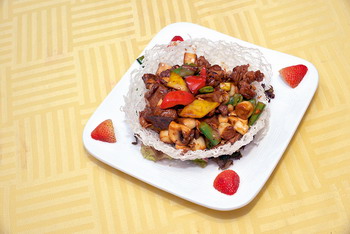 In this issue, we are honoured to have invited Chef LO Wai-leung to demonstrate how to prepare a mouth-watering dish - Angus Beef Tenderloin Cubes with Garlic. Chef LO, who started his career in 1978, is working with Charming Cuisine, a signatory of the Food Safety Charter in Causeway Bay.
In this issue, we are honoured to have invited Chef LO Wai-leung to demonstrate how to prepare a mouth-watering dish - Angus Beef Tenderloin Cubes with Garlic. Chef LO, who started his career in 1978, is working with Charming Cuisine, a signatory of the Food Safety Charter in Causeway Bay.
| Preparation Steps | Small Tips, Big Wisdom | ||
|---|---|---|---|
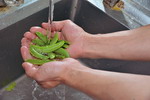 |
Receiving | First, purchase frozen Angus beef tenderloin and other ingredients such as fresh white mushrooms and honey peas from approved and reliable sources. | Upon receipt of the ingredients, check with meticulous care to ensure their freshness. Frozen beef tenderloin should be stored in a refrigerator at -18oC or below. Make sure that the fresh white mushrooms are firm and the honey peas bright green in colour. |
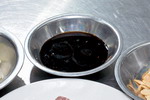 |
Preparing the sauce | Blend barbecue sauce, beef sauce and eel sauce together. Set aside. | Pay attention to the environment and temperature of the place where the sauces are stored once their lids are opened. |
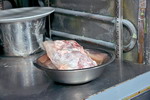 |
Defrosting | Defrost frozen beef tenderloin in a thaw cabinet. | Defrosting in a refrigerator at 4oC or below not only ensures food safety but also keeps the fresh taste of beef tenderloin. |
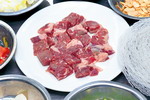 |
Cutting | Cut the beef tenderloin into cubes. | It is easier to cook food thoroughly if the food is cut into cubes. |
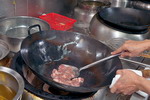 |
Frying | Fry the tenderloin cubes until fragrant. Set aside. | Frying tenderloin cubes beforehand can shorten the time for stir-frying in wok in the final step. |
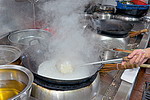 |
Blanching | Blanch other ingredients in boiling water for 1 or 2 minutes. Drain them dry and set aside. | Blanching ingredients in boiling water can remove the grassy smell of mushrooms and peas. |
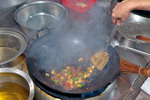 |
Stir-frying | Add the fried tenderloin cubes and the blanched ingredients to the sauce, leeks and fried garlic in wok. Mix and stir-fry until fragrant. Ready to serve. | Brisk stir-frying in wok makes ingredients taste better and ensures that they are cooked thoroughly. |
Tips from Chef LO:
-
Control the heat and the duration when frying the beef tenderloin cubes, or the beef will become overcooked and dry.
-
The barbecue sauce, beef sauce and eel sauce should stay in an appropriate proportion so as not to be too salty or sweet.
-
The addition of leeks and a little fried garlic can enhance the fragrance of the food.
-
Blanching ingredients (such as white mushrooms, red and yellow sweet peppers and honey peas) in boiling water for 1 or 2 minutes beforehand can shorten the time for subsequent stir-frying in wok with oil at a high temperature. This is certainly a tip for making a healthy dish.

Food Safety Plan Corner
Angus Beef Tenderloin Cubes with Garlic
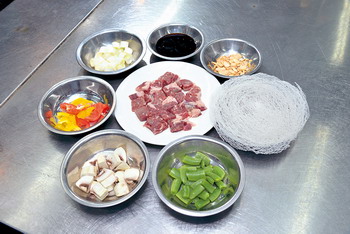
Ingredients:
Beef tenderloin, white mushrooms, red and yellow sweet peppers, honey peas, leeks and sliced garlic
Sauces:
Barbecue sauce , beef sauce and eel sauce
Steps:
- Defrost frozen beef tenderloin in a refrigerator at 4oC or below.
- Cut ingredients into cubes.
- Fry beef tenderloin until half done.
- Blanch white mushrooms, red and yellow sweet peppers and honey peas.
- Stir-fry leeks and sliced garlic in wok. Add beef tenderloin, white mushrooms, red and yellow sweet peppers, honey peas and seasoning and stir-fry until cooked. Ready to serve.
Briefing of Activities
Food Safety Charter
The Food Safety Charter has been jointly developed by the CFS and the food trade. Since its establishment, the Food Safety Charter has been providing facilitation for the food trade to incorporate appropriate measures in their day-to-day practices, so as to provide innovative and client-oriented quality services well-grounded on food safety to Hong Kong citizens and tourists from all over the world.
Apart from compliance with legal requirements, the World Health Organization promulgates the Five Keys to Food Safety for all members of the trade and the public to ensure food safety. The Five Keys to Food Safety are:
1. Choose
2. Clean
3. Separate
4. Cook
5. Safe Temperature
A Charter Signatory Undertakes to:
- support the Food Safety Charter
- keep updated on food safety development, enhance food safety, and promote good image of the food trade
- provide safe and healthier food by making reference to CFS guidelines
How to Search for Food Trade Signatories:
To locate food trade signatories, members of the public may visit the CFS webpage dedicated for the Food Safety Charter and OpenRice.com.
Upcoming Activities
Public Talks 2014
To enhance the awareness and knowledge of the public on food hygiene and safety, the CFS plans to assign experienced health inspectors of its Communication Resource Unit to deliver food hygiene talks in 2014. The talks, with the target audience being the general public in various districts, will be conducted in Cantonese and the duration of each talk will be about 2 hours. Leaflets and souvenirs promoting food safety will be given out during the talks. New arrangements of the talks will be announced regularly and members of the public are welcome to visit the CFS website. For any enquiries, please contact our Communication Resource Unit on 2381 6096.

Food Safety Q&A
Q: What kinds of fruits and vegetables contain natural toxins?
A: Fruits and vegetables commonly found with natural toxins include beans, cassavas, bamboo shoots, fresh daylily flowers, potatoes, ginkgo seeds, as well as fruit seeds and stones.
1. Beans (such as string beans, red kidney beans and white kidney beans) - these varieties of beans contain a natural toxin known as phytohaemagglutinin. Consumption of these toxin-containing beans which are uncooked or undercooked may cause food poisoning within a short time of one to three hours and victims may suffer from symptoms like nausea, vomiting and diarrhoea. Nevertheless, this toxic substance can be destroyed by soaking the beans well and cooking them thoroughly at boiling temperature. As canned beans have been thoroughly processed at high temperature, they are safe to consume without further cooking.
2. Cassavas - they refer to the edible roots of cassava plants. While cassavas contain a natural toxin known as cyanogenic glycoside, the toxin levels are higher in bitter cassavas than in sweet cassavas. When uncooked or undercooked cassavas are ingested, the toxin present will transform into a chemical called hydrogen cyanide, which may result in food poisoning. Symptoms of cyanide poisoning, which may occur within a few minutes, include constriction of the throat, nausea, vomiting, headache, etc., and even deaths in severe cases.
3. Bamboo shoots - the toxicological profile of bamboo shoots is similar to that of cassavas. The natural toxin, cyanogenic glycoside, in fresh bamboo shoots may lead to food poisoning when consumed. Symptoms of poisoning are the same as those caused by cassavas. To render them safe for consumption, fresh bamboo shoots should be sliced into thin pieces and cooked thoroughly.
4. Fruit seeds and stones* - these refer to seeds or stones of apples, apricots, pears, plums, prunes, cherries, peaches, etc. The flesh of these fruits does not contain toxins, but the stones (such as kernels of bitter apricots) and seeds contain cyanogenic glycoside. When fresh stones or seeds are chewed, the cyanogenic glycoside present will transform into hydrogen cyanide which is toxic. Young children are most susceptible to cyanide poisoning and they may be poisoned by only swallowing a few seeds/the stone. Symptoms of poisoning are the same as those caused by cassavas and bamboo shoots. (*A stone refers to the large hard seed in the fruit.)
5. Fresh daylily flowers - they are the floral part of a plant harvested before the flowers blossom. Fresh daylily flowers have been used as fresh vegetables in dishes. A natural toxin known as colchicine is concentrated in the root and the floral part of the plant. Consumption of fresh daylily flowers which have not been properly processed may result in poisoning, the symptoms of which include gastrointestinal discomfort such as abdominal pain, vomiting and diarrhoea. Nonetheless, colchicine in fresh daylily flowers will be destroyed during the drying and cooking processes and therefore dried daylily flowers is non-toxic.
6. Potatoes - potatoes contain natural toxins called glycoalkaloids. The levels of these toxins are usually low and do not pose adverse effects to humans. However, potatoes that show signs of greening, sprouting, physical damage or rotting may contain high levels of glycoalkaloids. The majority of these toxins are found in the green area, in the peel, or just below the peel of the potatoes. Potatoes containing high levels of glycoalkaloids taste bitter. Symptoms of glycoalkaloid poisoning may include a burning sensation in the mouth or severe stomach ache, nausea and vomiting. Cooking and frying cannot destroy glycoalkaloids.
7. Ginkgo seeds - ginkgo seeds contain toxins which are neurotoxic. Typical symptoms of ginkgo seeds poisoning like vomiting, irritability and tonic or clonic convulsions usually develop 1 to 12 hours after ingestion. Children are more susceptible to this type of food poisoning. In severe cases where large amounts have been taken or in susceptible individuals, loss of consciousness and deaths may occur. It has been reported that the ingestion of 10 to 50 cooked ginkgo seeds at one time can cause acute poisoning in humans. The unripe and uncooked seeds are more toxic and cooking can lower their toxicity.
How to Reduce the Risk
Food poisoning caused by natural toxins in fruits and vegetables can be avoided or the risk significantly reduced by taking the following measures:
Selection of Food
- Buy food from reliable shops and do not patronise unlicensed hawkers.
- Do not buy potatoes that show signs of greening or sprouting.
- Do not eat fruits and vegetables raw or undercooked if they usually need to be cooked before consumption.
Preparation and Consumption
- Soak beans, such as string beans, red kidney beans and white kidney beans, cassavas and bamboo shoots well in clean water before cooking them thoroughly at boiling temperature.
- When preparing salad, do not use string beans or other beans which are uncooked or undercooked. Bear in mind even a small amount of raw beans can cause food poisoning.
- When eating fresh fruits such as apples, apricots and pears, avoid consuming their seeds/stones. However, their flesh is nutritious and safe to eat.
- Cook kernels of bitter apricots thoroughly and eat them in strict moderation.
- If fresh daylily flowers are included in the recipe, soak them well in clean water before cooking and then cook them thoroughly.
- Store potatoes in a cool, dark, dry environment. Avoid eating potatoes that show signs of greening, sprouting, or rotting.
- Limit the intake of ginkgo seeds to not more than a few seeds per day and never eat them raw. Children, in particular, should not overeat ginkgo seeds or eat raw ginkgo seeds.
Fruits and vegetables are nutritious. Eat plenty of them daily to maintain a balanced diet.
Truth against Fallacy
Does the claim "Sugars free" marked or made on nutrition labels of prepackaged food products mean that the food does not contain sugars (zero sugars)?
"Sugars free" is one of the nutrient content claims used to describe the level of sugars in a food. With the implementation of the Nutrition Labelling Scheme, any food bearing a "Sugars free" claim must meet the requirement of containing not more than 0.5 g of sugars per 100 g/mL of the food. Therefore, the claim "Sugars free" marked or made on nutrition labels only means that the food contains no more than 0.5 g of sugars per 100 g/mL.
Brain Gym
True or False
- Hot food should be stored at above 60oC .
- Raw meat, poultry and seafood should be stored on the top shelf of the refrigerator.
- Cooked and perishable food should be refrigerated within 2 hours.
- It is not necessary to check the temperature of the refrigerator with a thermometer regularly.
Answers:
(1) true (2) false (3) true (4) false
Enquiry and Subscription
Printed copies of the Food Safety Express can be obtained from the Communication Resource Unit located at 8/F, Fa Yuen Street Municipal Services Building, 123A Fa Yuen Street, Mong Kok, Kowloon. For enquiry, please call 2381 6096. The public may also visit the website of the CFS (http://www.cfs.gov.hk) for the online version.
